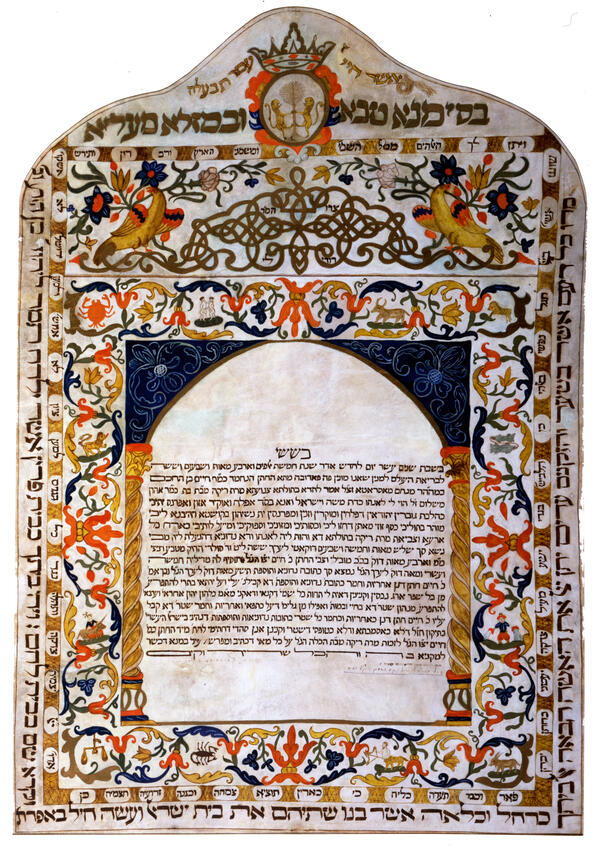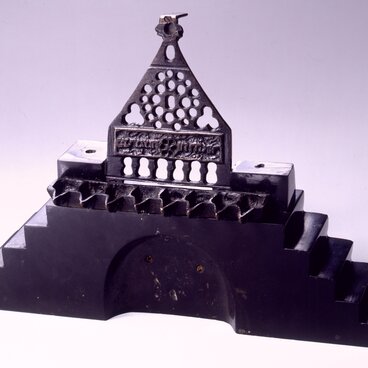The ketubah from the collection of the Russian Museum of Ethnography is a Jewish marriage contract dated 12 Adar 5476 (March 6, 1716). On that day Hayyim, son of Menachem Massarat, and Rika, daughter of Aaron Shalom, were engaged. According to the marriage contract, the husband took it upon himself to support his wife and provide her with shelter, food, and clothing, as was proper for “worthy Jewish husbands”. In the event of divorce or her husband’s death, the ketubah guaranteed the wife a stipulated sum of money.
Although the ketubah had a practical sense to it, it was written in a poetic language. The tradition of decorating the ketubah with colorful designs, illustrations, quotations from scriptures, and zodiac signs turned it into a piece of graphic art. The decorative design of the ketubah of Hayyim and Rika was executed in the style of the Venetian school.
Married life in Jewish tradition was always considered the natural state of man in terms of morality. According to an old saying, “A single man lives without joy, without blessing and without happiness, without Torah, without protection, without peace.” Like in many cultures, Jewish weddings were arranged by matchmakers. The bride and groom had no say throughout the pre-wedding period, and sometimes they met for the first time only at the ceremony.
A Jewish wedding traditionally had two stages: the kiddushin (betrothal) and nissuin (marriage). Part of the engagement was a special ritual, tenayim, an arrangement between the parties of the bride and groom. It signified agreement to the marriage and to all the terms of conducting the wedding. The tenayim ended with a handshake, a festive dinner and the symbolic smashing of a crockery. The elders of the bride and groom’s family drew up a document that officially and publicly fixed the intentions of the young. This paper was called the ketubah.
The text of the ketubah was read aloud after the groom put the ring on the bride’s finger in the presence of two witnesses. At that moment the couple was under the chupah, a special wedding canopy, with only their closest relatives present. Hearing the text of the ketubah at a wedding was considered a great honor for the guests. The ketubah was an important document, and if it was lost, the spouses were forbidden to live together until a new contract was drawn up.
Although the ketubah had a practical sense to it, it was written in a poetic language. The tradition of decorating the ketubah with colorful designs, illustrations, quotations from scriptures, and zodiac signs turned it into a piece of graphic art. The decorative design of the ketubah of Hayyim and Rika was executed in the style of the Venetian school.
Married life in Jewish tradition was always considered the natural state of man in terms of morality. According to an old saying, “A single man lives without joy, without blessing and without happiness, without Torah, without protection, without peace.” Like in many cultures, Jewish weddings were arranged by matchmakers. The bride and groom had no say throughout the pre-wedding period, and sometimes they met for the first time only at the ceremony.
A Jewish wedding traditionally had two stages: the kiddushin (betrothal) and nissuin (marriage). Part of the engagement was a special ritual, tenayim, an arrangement between the parties of the bride and groom. It signified agreement to the marriage and to all the terms of conducting the wedding. The tenayim ended with a handshake, a festive dinner and the symbolic smashing of a crockery. The elders of the bride and groom’s family drew up a document that officially and publicly fixed the intentions of the young. This paper was called the ketubah.
The text of the ketubah was read aloud after the groom put the ring on the bride’s finger in the presence of two witnesses. At that moment the couple was under the chupah, a special wedding canopy, with only their closest relatives present. Hearing the text of the ketubah at a wedding was considered a great honor for the guests. The ketubah was an important document, and if it was lost, the spouses were forbidden to live together until a new contract was drawn up.



